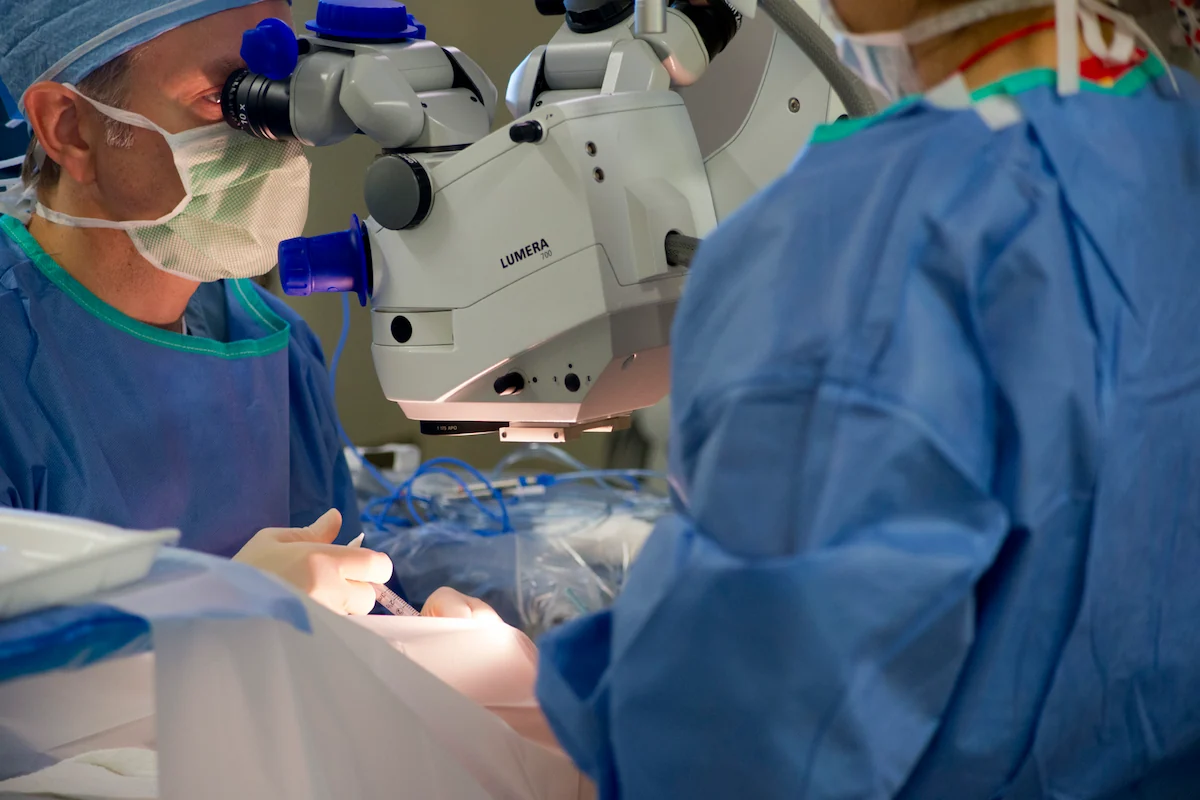Refractive Lens Exchange

At Diagnostic Eye Center in Houston, we offer a full range of vision solutions so that our patients can choose the option that’s best for their unique needs and lifestyles. One such option is refractive lens exchange, which can correct vision at a range of distances.
- What is Refractive Lens Exchange?
- What Does Refractive Lens Exchange Treat?
- What are the Benefits of Refractive Lens Exchange?
- Who is a Candidate for Refractive Lens Exchange?
- Intraocular Lens Options for Refractive Lens Exchange
- Preparing for Refractive Lens Exchange
- What Happens During Refractive Lens Exchange?
- Refractive Lens Exchange Recovery and Results
- Common Questions About Refractive Lens Exchange
What is Refractive Lens Exchange?
Refractive lens exchange may be referred to by a number of different names: RLE, clear lens exchange, or clear lens extraction. RLE is a vision correction procedure that works by removing the natural lens of the eye and replacing it with an artificial intraocular lens (IOL) customized to improve the patient’s vision.
The refractive lens exchange procedure is identical to cataract surgery. The only difference is that this is an elective procedure designed for patients who don’t have cataracts but who desire clearer vision. Refractive lens exchange is often a good option for our patients who aren’t candidates for other refractive surgery procedures like LASIK and PRK. An added benefit is that, unlike LASIK, RLE can treat vision at a range of distances and can be fully customized to each patient’s unique goals.

What Does Refractive Lens Exchange Treat?
Refractive lens exchange can be performed to treat common refractive errors, which are problems with the way the eye refracts light onto the retina to produce clear images. Refractive errors we can treat with RLE include:
Nearsightedness (myopia):
Trusted Source
Myopia (nearsightedness)
American Optometric Association
Go to Source
Up to 30%
of people in the United States are nearsighted. This refractive error makes it difficult to clearly see objects in the distance.
Farsightedness (hyperopia): the opposite of nearsightedness, farsightedness affects a person’s ability to see objects up close.
Astigmatism: Astigmatism can affect vision at all distances
Presbyopia: Presbyopia is also known as age-related near vision loss. As we age, the lens of the eye becomes more rigid and is less able to bend when we need to focus on reading and other up-close activities. Because RLE involves replacing the lens of the eye, it is a great treatment for presbyopia.
What are the Benefits of Refractive Lens Exchange?
Refractive lens exchange is an excellent option for many of our patients who want to reduce or eliminate their dependence on eyeglasses or contacts. Benefits include:
- Improvement of refractive errors like nearsightedness, farsightedness, astigmatism, and presbyopia
- A fast, comfortable procedure
- Short recovery period
- Potentially a good option for patients who aren’t candidates for other vision correction surgeries
- Eliminates the need for cataract surgery in the future
"State of art equipment, with excellent clinicians handling them. Professionals who at up to date with the latest information in their field. I travel an hour for my visits because they are invested in providing the best care for my eyes."

Who is a Candidate for Refractive Lens Exchange?
Refractive lens exchange is a popular option for patients over the age of 40 who wish to correct presbyopia (age-related near vision loss) or who have other
Trusted Source
Refractive lens exchange in modern practice: when and when not to do it?
Alió JL, Grzybowski A, Romaniuk D
Go to Source
refractive errors
that aren’t well-treated by laser vision correction procedures.
A good candidate for RLE:
- Is over the age of 40
- Has been diagnosed with presbyopia
- Is not a good candidate for other refractive procedures
- Has healthy eyes with no risk of retinal detachment
Intraocular Lens Options for Refractive Lens Exchange
Because our goal is to help each patient achieve their best possible vision, we offer a range of intraocular lens (IOL) options to our patients undergoing refractive lens exchange.
PanOptix™ IOL
The PanOptix trifocal IOL gives our patients clear intermediate vision in addition to improving near and distance vision.
Vivity™ IOL
With the Vivity IOL, our patients can achieve exceptional distance vision in addition to improvements in their near and intermediate vision. Vivity also protects the eyes against UV rays and filters blue light rays. We also offer a toric Vivity lens, which corrects visual errors caused by astigmatism.
Symfony™ Extended Depth of Focus IOL
The TECNIS Symfony extended depth of focus (EDOF) lens gives patients high-quality distance and intermediate vision. Patients who choose this lens may still need reading glasses for some tasks.
Synergy™ IOL
The synergy IOL by Tecnis is a multifocal lens that affords patients the broadest range of vision and can also treat presbyopia.
Toric IOLs
Toric IOLs are specifically designed to treat astigmatism, which is caused by irregularities in the shape of the cornea.

Preparing for Refractive Lens Exchange
Preparing for RLE starts with an eye exam and consultation with one of our experienced ophthalmologists. Once you are deemed a candidate for refractive lens exchange, your doctor will educate you about the many IOL options we offer, and together you will decide which is best for you. Then your procedure will be scheduled and we’ll give you detailed pre- and postoperative instructions.


What Happens During Refractive Lens Exchange?
Refractive lens exchange is an outpatient procedure that takes only about 10 minutes.
Before the procedure begins, your eye surgeon will use anesthetic eye drops to numb your eyes. You will also be offered an oral sedative to help you relax, and a device called a speculum will be used to gently hold your eyes open for the duration of the procedure.
Once you are comfortable, your eye surgeon will create a small incision, removing your eye’s natural lens and positioning your intraocular lens implant. That’s it! The incision for refractive lens exchange is so tiny that no sutures are needed: your eye will quickly heal itself.
Refractive Lens Exchange Recovery and Results
When you return home after your RLE eye surgery, you will be wearing a protective eye shield that you should keep on while sleeping for the first few days of your recovery period. It is common to experience temporarily blurry vision, mild discomfort, and/or itchiness, but this will resolve quickly. Please try not to rub or touch your eyes! Your eye doctor will prescribe antibiotic and anti-inflammatory eye drops and will give you instructions on when and how to use them.
Not much downtime is needed after RLE: most of our patients get back to work and their regular activities within 24-48 hours of their surgery.
Within a few weeks, you’ll be able to notice the complete extent of your vision improvement. You might even be able to stop wearing glasses and contact lenses all together!
Common Questions About Refractive Lens Exchange
The procedure for refractive lens exchange is identical to cataract surgery, which has an exceptional high rate of safety and patient satisfaction. Risks and complications, while rare, may include:
- Infection
- Bleeding
- Inflammation
- Dislocation of the IOL
-
Trusted Source Cataract Surgery American Academy of Ophthalmology Go to Source Retinal detachment
Because refractive lens exchange is an elective (not medically necessary) procedure, it is not covered by insurance. If you would like to learn more about payment and financing options for your RLE, we are happy to help.
During LASIK surgery, the shape of the cornea is changed to correct refractive errors, but can’t correct vision problems associated with the lens of the eye. RLE involves replacing the entire natural lens of the eye with an artificial lens. Because of this, our eye surgeons can perform RLE to correct presbyopia.
1 American Optometric Association. Myopia (nearsightedness). Available: https://www.aoa.org/patients-and-public/eye-and-vision-problems/glossary-of-eye-and-vision-conditions/myopia. Accessed December 1, 2022.
2 Alió JL, Grzybowski A, Romaniuk D. Refractive lens exchange in modern practice: when and when not to do it? Eye Vis (Lond). 2014 Dec 10;1:10. doi: 10.1186/s40662-014-0010-2. PMID: 26605356; PMCID: PMC4655463. Available: https://pubmed.ncbi.nlm.nih.gov/26605356/. Accessed December 1, 2022.
3 American Academy of Ophthalmology. Cataract Surgery. Available: https://www.aao.org/eye-health/diseases/what-is-cataract-surgery. Accessed December 1, 2022.
The doctors at Diagnostic Eye Center have reviewed and approved this content.

